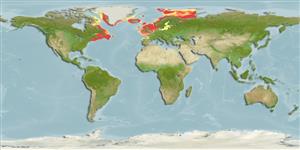Environment: milieu / climate zone / depth range / distribution range
Ecologia
marinhas demersal; não migratória (Ref. 88171); intervalo de profundidade 30 - 373 m (Ref. 58426), usually 40 - 100 m (Ref. 51666). Temperate; 8°C - 14°C (Ref. 89228); 80°N - 41°N, 71°W - 55°E
North Atlantic: Spitsbergen southward to Scandinavian coasts, North Sea, southern part of the Baltic, the Faroes, Iceland and south-eastern coasts of Greenland. Elsewhere, western coasts of Greenland; also, Labrador and Newfoundland to Massachusetts Bay (subspecies Lumpenus lumpretaeformis serpentinus Storer, Ref. 51666).
Length at first maturity / Tamanho / Peso / Idade
Maturity: Lm 20.0 range ? - ? cm
Max length : 50.0 cm TL macho/indeterminado; (Ref. 35388)
Elongated, eel-like fish with a pointed caudal fin. A single dorsal fin extends almost throughout the entire length of the body. The anal fin covers about two-thirds of the total length. Pale brown dorsally, becoming bluish on the sides, and greenish-yellow ventrally. There are numerous irregular brown patches on the body (Ref. 35388).
A benthic species (Ref. 58426), living in Y-shaped tubes in the mud in 50-200 m depth (Ref. 35388). The burrows are believed to be used for parental care of the eggs (Ref. 80819) . Feeds on small crustaceans, mollusks, brittle stars and worms (Ref. 5204). Matures at 3 years with about 20 cm length. Spawning takes place in December - January, 1,000 eggs are laid on the sea floor, in deep water (Ref. 35388). Isolated population in the Baltic Sea is probably a relict from the last ice age (Ref. 35388) that reached the Baltic Sea during the early saltwater stage of the sea (Ref. 82152; 82153).
Wheeler, A., 1992. A list of the common and scientific names of fishes of the British Isles. J. Fish Biol. 41(suppl.A):1-37. (Ref. 5204)
Categoria na Lista Vermelha da IUCN (Ref. 130435: Version 2024-1)
Ameaça para o homem
Harmless
Utilização humana
Pescarias: sem interesse
Ferramentas
Relatórios especiais
Descarregue XML
Fontes da internet
Estimates based on models
Preferred temperature (Ref.
123201): 0.4 - 8.5, mean 3.1 °C (based on 420 cells).
Phylogenetic diversity index (Ref.
82804): PD
50 = 0.6250 [Uniqueness, from 0.5 = low to 2.0 = high].
Bayesian length-weight: a=0.00129 (0.00050 - 0.00329), b=2.99 (2.77 - 3.21), in cm total length, based on LWR estimates for this (Sub)family-body shape (Ref.
93245).
Nível Trófico (Ref.
69278): 3.6 ±0.48 se; based on food items.
Generation time: 5.4 ( na - na) years. Estimated as median ln(3)/K based on 1
growth studies.
Resiliência (Ref.
120179): Médio, tempo mínimo de duplicação da população 1,4 - 4,4 anos (K=0.20; tmax=9;).
Fishing Vulnerability (Ref.
59153): Moderate to high vulnerability (50 of 100).
Nutrients (Ref.
124155): Calcium = 36.8 [21.4, 62.1] mg/100g; Iron = 0.32 [0.19, 0.54] mg/100g; Protein = 18.7 [16.4, 20.7] %; Omega3 = 0.439 [0.247, 0.728] g/100g; Selenium = 19.1 [10.2, 35.5] μg/100g; VitaminA = 12.9 [3.9, 41.6] μg/100g; Zinc = 0.527 [0.387, 0.735] mg/100g (wet weight);
